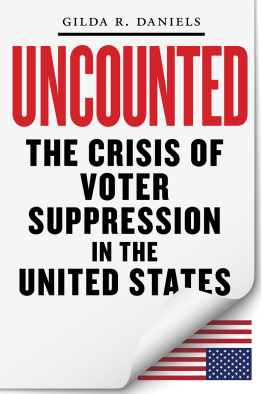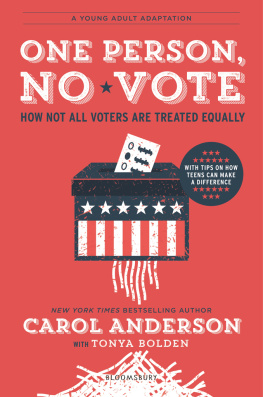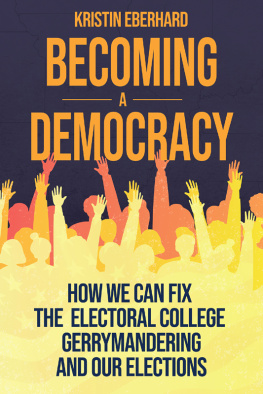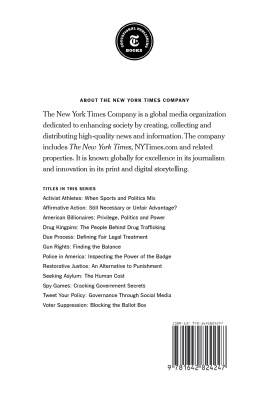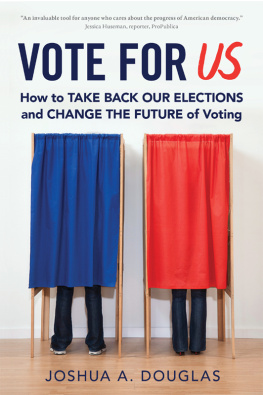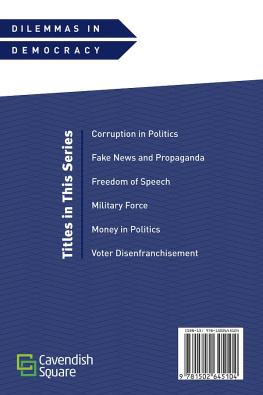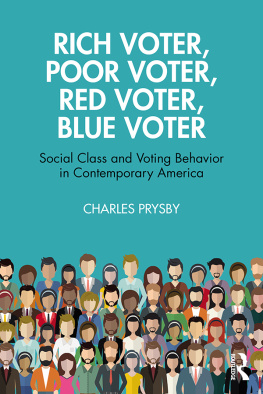NEW YORK UNIVERSITY PRESS
New York
www.nyupress.org
2020 by Gilda R. Daniels
All rights reserved
References to Internet websites (URLs) were accurate at the time of writing. Neither the author nor New York University Press is responsible for URLs that may have expired or changed since the manuscript was prepared.
Library of Congress Cataloging-in-Publication Data
Names: Daniels, Gilda R., author.
Title: Uncounted : The crisis of voter suppression in the United States / Gilda R. Daniels.
Description: New York : New York University Press, [2020] | Identifiers: LCCN 2019012053| ISBN 9781479862351 (cl.) | ISBN 1479862355 (cl.)
Subjects: LCSH : SuffrageUnited States. | SuffrageUnited StatesHistory. | Voter registrationCorrupt practicesUnited States. | Voter registrationCorrupt practicesUnited StatesHistory. | ElectionsCorrupt practicesUnited States. | ElectionsCorrupt practicesUnited StatesHistory.
Classification: LCC KF4891 .D36 2019 | DDC 324.6/20973dc23
LC record available at https://lccn.loc.gov/2019012053
New York University Press books are printed on acid-free paper, and their binding materials are chosen for strength and durability. We strive to use environmentally responsible suppliers and materials to the greatest extent possible in publishing our books.
Manufactured in the United States of America
10 9 8 7 6 5 4 3 2 1
Also available as an ebook
Sleeping at a dangerous time!
Rev. Fluney Jackson
Growing up in rural Louisiana, my grandparents were a treasure trove of advice and sound wisdom that far outpaced their formal education. My grandfather, a sharecropper with a fifth-grade education, taught himself to read. My grandmother worked as a domestic well into her eighties. They raised my mother and aunt, provided a loving family environment for many nonbiological children in the community, and hosted me and my siblings for occasional sleepovers.
On those crisp Saturday mornings when the sun would peek between the cotton curtains with the small faded pattern, my grandpa would allow me to sleep a few extra minutes, but not too much. He would tiptoe into my room off the front porch and say in a stern but loving voice, Sleeping at a dangerous time! As a child, I had no idea what that meant. I certainly did not sense any danger after a peaceful night of sleep.
Several decades have passed since my grandfathers morning alarm, and only now can I fully understand it. After being a civil rights attorney for nearly thirty years, the full context and impact of my grandfathers admonition rings like a clarion bell. It is against the backdrop of history aided by the cogency of unobstructed vision and experience that a young woman can understand the words of a wise elder. My grandfathers warning was not about sleeping at all. It was a caution that things were happening while I slept comfortably. I was sleeping at a time when vigilance was needed. I have never forgotten his warning, and I offer it today.
As a country, we have slept through the continuous assault on access to the ballot box in the name of stricter voting requirements, meritless claims of rigged elections, and baseless voter-fraud proclamations. These laws, however, have created a crisis. In the past, these efforts had the primary purpose of eliminating African American voters from the voter rolls. In the new millennium, the enacted laws not only seek to abolish members of a political party but, with the same result, to eliminate voters of color. Obstructionists use race as a political proxy, and substitute party for race by targeting Democratic Party voters and adopting laws that seek to disenfranchise, frustrate, and eliminate minority, poor, and elderly voters. A premeditated strategy composed of laws and deceptive practices has taken root and is eroding the very basis of American democracythe right to vote! We are, as my grandfather cautioned many years ago, sleeping at a dangerous time.
The proliferation of election administration legislation on the federal and state level since the 2000 presidential election has amassed legislative measures that affect access to the ballot.strategies that can preserve the right to vote from the hands of those who seek to return to the days when only certain Americans could exercise the right to vote without fear.
These are not new attacks on the right to vote. Laws have been proposed and enacted that specifically sought to affect voters of color since the late 1800s and the passage of the Fifteenth Amendment. Moreover, the courts have also been involved in endorsing and restricting these types of laws.
Uncounted examines this phenomenon through the lenses of history, race, law, and the democratic process. It seeks to educate and create power within communities that are severely and regularly disenfranchised. Surely, a way exists that can expand the franchise without sacrificing integrity. What has worked to combat these perennial disenfranchising methods? How do voter ID and other new-millennium methods affect voter participation and confidence? Are these new mechanisms similar in effect to Jim Crowera laws of the past? Consider this: If you could get rid of voters, eligible voters, without violence and within legal means, would you try it? What if the affected voters were predisposed to vote against you, or so you believed? Would you use or propose laws that had this effect? What role could courts play in endorsing or revoking these laws?
Enfranchisement-minded grassroots organizers, advocacy groups, and determined voters hold the key to unlocking the prize of democracy, the right to vote. Uncounted does more than identify new-millennium methods. It explores methods that take away the right to vote, while we sleep. Were sleeping comfortably while the right to vote is suffering debilitating blows in the courts and legislative houses across this nation. This book will address the similarities between the more overt and ferocious methods of affecting access to voting with the contemporary ways that we currently endure. Indeed, it will provide the wakeup call that is needed to move beyond the strangulation of voter access versus voter integrity to methods that provide for unencumbered voter participation. It illuminates these deceptive and conniving methods and wakes us to an eye-opening revelation of the power of the vote and the ongoing efforts to take the power away from the people. It provides a framework for understanding voter suppression, its roots in the founding and evolution of our democracy, our contemporaneous struggle to vote, and what must be done to dismantle this suppressive system.
Each chapter will discuss the historical counterpoints to a contemporaneous suppressive tactic, the laws that allow these mechanisms to continue, the impact of the disenfranchising devices with accounts from real voters, and solutions to break the cycle of voter suppression. In chapter 1, I introduce the historical context of disenfranchising legislation and reveal the striking similarities between the pre-civil-rights-era methods of violence and intimidation to specifically disenfranchise black voters and the new-millennium methods of disenfranchisement via legislation and litigation. Using my almost-one-hundred-year-old grandmother as the framework for this discussion, I will illustrate the real impact of voting laws on people of color.

